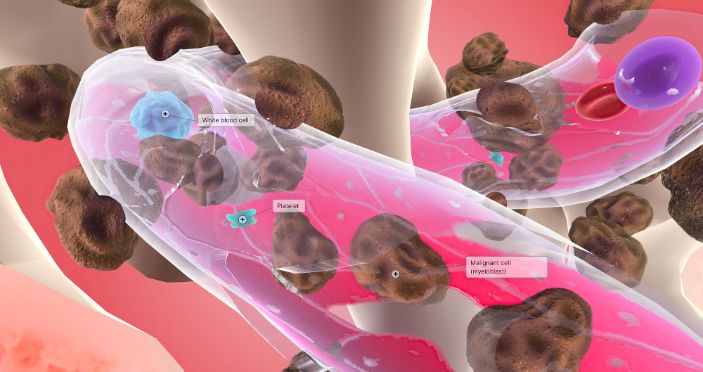Leukemia is cancer that starts in blood-forming cells called stem cells. It usually begins in cells that normally become white blood cells, but it can also start in other types of blood-forming cells. With acute myeloid leukemia (AML), too many immature blood-forming cells build up in the bone marrow and blood, crowding out healthy cells and blocking them from doing their jobs. This can make it hard for the blood to carry oxygen, fight infections, or clot blood properly. AML can also cause anemia, which makes you tired. It can also weaken your immune system, allowing you to get frequent infections. It can also cause a buildup of abnormal platelets in the blood, which can lead to easy bruising and bleeding. AML most often affects adults over 60, but it can happen to people of any age. It can also be more common in people who have a history of other blood disorders, like myelodysplastic syndromes, or certain genetic diseases, such as Down syndrome, trisomy 8, or Li-Fraumeni syndrome.
The name acute myeloid leukemia refers to the type of blood-forming cell where the cancer starts. The cancer cells in this type of leukemia are called myeloblasts. They normally grow and develop into mature red blood cells, platelets, and granulocytes, a type of white blood cell. These cells are important for your body to function. But with acute myeloid leukemia, these cells produce too many immature blood cells and don’t die as they should. The extra cells crowd out healthy blood-forming cells, and the lack of new blood-forming cells makes it hard for your body to get the oxygen it needs, causing anemia. It also limits the production of normal white blood cells, which can lead to a weak immune system and more infections.

This cancer can spread from the blood to other parts of the body, including the spleen, liver, central nervous system (brain and spinal cord), skin, and testicles. It can also be more serious if it spreads to the lungs.
Healthcare providers use several tests to diagnose AML. They take a medical history and do a physical exam. They will check for a swollen spleen or liver, and they will look for bruising or bleeding. They will order blood tests to measure the levels of red and white blood cells, and platelets.
The goal of the first phase of treatment, called remission induction therapy, is to kill leukemia cells in the blood and bone marrow. This puts the leukemia into remission. The second phase, called postremission therapy, aims to prevent the cancer from coming back and spreading, or relapsing. This includes chemotherapy and sometimes radiation and other types of treatments. It can also include blood transfusions, and medicine to treat symptoms, such as fatigue, nausea, or infection. This PDQ cancer information summary has current information about the treatment of acute myeloid leukemia in adults. It was reviewed by experts at the National Cancer Institute (NCI) and is updated regularly.








